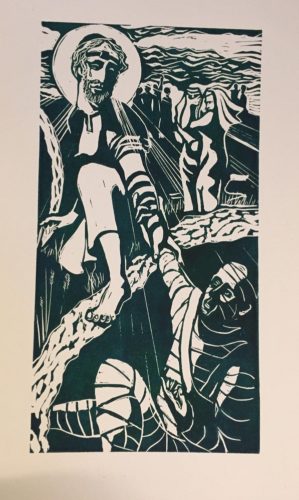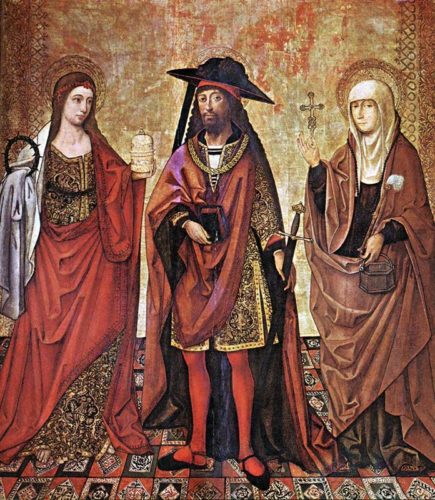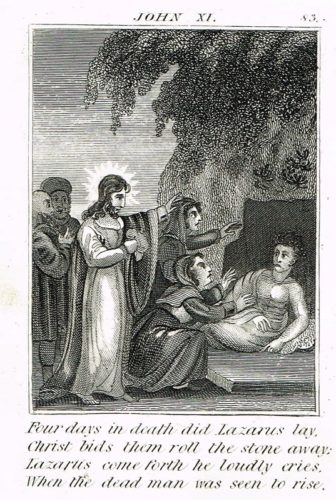Last Updated on January 9, 2024 by Kittredge Cherry
Some believe that Lazarus of Bethany was the “beloved disciple” of Jesus — and maybe even his same-sex lover. He is celebrated on July 29 in contemporary Catholic and Protestant churches. His feast day used to be Dec. 17 in the earlier editions of the Roman Catholic calendar.
Scholars theorize that Lazarus was also the unnamed “one whom Jesus loved,” also known as “the beloved disciple,” referenced at least five times in the Gospel of John. The term implies that Jesus was in love with him, and perhaps they shared the kind of intimacy that today would be called “gay.” Bible experts suggest that Lazarus was the unnamed naked man or “naked fugitive” who ran away when Jesus was arrested in Mark 14:51-52. He may also have been the queer water carrier who led the way to the Last Supper and/or the nameless “rich young ruler” who asks Jesus how to find eternal life in all three synoptic gospels. Possibly he was the angel in the tomb of Jesus, described as “a young man dressed in a white robe” in Mark 16:1-8. Losing your garment could be a euphemism for dying.
Lazarus and his sisters Mary and Martha of Bethany formed a nontraditional family at a time when there was huge pressure for heterosexual marriage. All three of them were close to Jesus.
Lazarus was raised from the dead by Jesus in a dramatic miracle told in John: 11. The Bible identifies him as a man living in the village of Bethany with his sisters Mary and Martha. Lazarus falls ill, and the sisters send a message to Jesus that “the one you love is sick.”

“Raising of Lazarus,” 1905 (Wikimedia Commons)
By the time Jesus arrives, Lazarus has been dead in his tomb for four days. Jesus weeps at the tomb, then calls, “Lazarus, come out!” To the amazement of all, Lazarus is restored to life. Lazarus coming out of the tomb has been seen as a symbol for LGBTQ people coming out of the closet by some LGBTQ people of faith.
According to legend, Mary, Martha and Lazarus continued in ministry together for decades in foreign lands. Orthodox tradition says that they fled persecution in Judea and moved to Cyprus, where Lazarus became the first bishop of Kition (modern Larnaca). In Roman Catholic tradition, they spread the gospel in Provence, France, where Lazarus become the first bishop of Marseille.
In Santeria, Lazarus syncretized as Babalu Aye, a Yoruba diety and with a reputation of healing the sick, especially as a patron for people facing AIDS and other pandemics.
Lazarus in art
 |
| “Crucifixion” by Christopher Olwage |

“Lazarus! Come Out!” by Tony O’Connell. Limited-edition prints are available at his Hallowed Prints Etsy shop.
“Lazarus! Come Out!” by queer British artist Tony O’Connell emphasizes how the love between the two men was stronger than death. Even Jesus struggles and is almost lost into the darkness as he struggles to overcome death itself. Mary and Martha, the other members of this seemingly queer family, hug each other as Jesus pulls Lazarus from the grave. O’Connell credits Q Spirit articles by Kittredge Cherry for drawing him into the story of Lazarus, Mary and Martha and its layered queer symbolism.
O’Connell was also influenced by the COVID-19 pandemic when he created the linocut print in 2021. He wrote:
“After the very challenging year of lockdown I wanted to make a symbol for hope and was interested in this narrative. The idea that a beloved friend could come back to us and the emotional drama of the idea… resulted in this image. I wanted to balance the living against the dead and the light against the darkness — that led me to this composition which focuses on the faces of the two main characters of Jesus and Lazarus, the grasp of their hands, on Jesus’s Jewishness and the characters of Mary and Martha shown mourning in the background even as the bystanders celebrate the miracle.”
Gay artist Eric Martin (1960-2017) devoted himself to learning about and depicting the nameless nude who ran away when Jesus was arrested in “Stripped of Linen, Stripped of Lord” and other paintings. For more info, see my previous post “Seeking the ‘naked young man’ of Mark’s gospel.”
Exploring the queer Lazarus
The Man Jesus Loved: Homoerotic Narratives from the New Testament by Theodore Jennings is a comprehensive book that explores the possibility of Lazarus as Jesus’ lover — and all the other major queer theories about the beloved disciple. Other identities proposed for the beloved disciple include John the Evangelist and even Judas, the disciple who betrayed Jesus.
More queer ideas about Lazarus come from the controversial Secret Gospel of Mark, a recently discovered gospel that goes into homoerotic detail about Jesus’ relations with the “naked youth” who is often identified as Lazarus. The lost gospel was discovered in 1958 by Morton Smith, professor of ancient history at Columbia University, and described his his book The Secret Gospel: The Discovery and Interpretation of the Secret Gospel According to Mark. More recently Secret Mark has been discredited as a possible hoax in books such as The Gospel Hoax: Morton Smith’s Invention of Secret Mark by Stephen C. Carlson. The controversy is also explored in a chapter titled “The Forgery of an Ancient Discovery? Morton Smith and the Secret Gospel of Mark” in the book “Lost Christianities: The Battles for Scripture and the Faiths We Never Knew” by Bart D. Ehrman.
Maybe Lazarus’ unusual family also included lesbians. Rev. Nancy Wilson, moderator of Metropolitan Community Churches, raises this possibility in her book “Outing the Bible: Queer Folks, God, Jesus, and the Christian Scriptures and her brochure “Our Story Too: Reading the Bible with New Eyes,” which says:
“Jesus loved Lazarus, Mary and Martha. What drew Jesus to this very non-traditional family group of a bachelor brother living with two spinster sisters? Two barren women and a eunuch are Jesus’ adult family of choice. Are we to assume they were all celibate heterosexuals? What if Mary and Martha were not sisters but called each other ‘sister’ as did most lesbian couples throughout recorded history?”
This potentially queer triad of two “sisters” and their “brother” is portrayed in a 16th-century painting of Mary, Martha and Lazarus by the Spanish artist known as the Master of Perea.

Lazarus between sisters Martha and Mary by the Master of Perea (Wikipedia)
Queer Lazarus in prayer
A collect for Lazarus was written in 2022 by Micah Ketchens, a queer liturgist out of Appalachia:
Resurrecting God, who bids us come out: Breathe upon us and grant us new life, that we may glorify you as we learn from the example of your servant Lazarus. Help us to follow the path of the one who loved him; he who defeated death, Jesus Christ our Lord, who lives and reigns with you and the Holy Spirit, one God, for ever and ever. Amen.
It is part of what Ketchens hopes will become an ongoing series (and eventually a book) of prayers and readings for a queer calendar of saints. His lectionary projects include “The Book of Dolly.”
Lazarus in gay poetry
Queer poet Jim Wise writes about the love between Jesus and Lazarus in an unpublished sacred homoerotic poem from his “Queer Psalter” collection:
Wise describes himself as “Queer Poet, Hermetic Mendicant, and Pantheist, itinerant theologist and roving Chaote – an Earth-centered, Eros-loving, Logos-chasing, dirt-worshiping revolutionary – living in Indianapolis with my partner Steven Chen.”
He considers himself “something of a UCC Old Catholic spiritual pilgrim” because he attended seminary under sponsorship of the United Church of Christ and was ordained in an Old Catholic jurisdiction. The following poem comes from his “Queer Psalter” collection, currently a work in progress. Wise’s poetry has appeared in RFD Journal, The Gay and Lesbian Review Worldwide, and a host of online literary journals and zines.
Lazarus
by Jim Wise
The most human
moment in the life of
Jesus happened at
Lazarus’ grave,
for who among us
has not screamed at
one we loved and lost
to come back?
He cried for you, Lazarus,
Whether Jesus was
a god who was a man
or
a man who was a god
or
just a man good enough
and wise enough to become
full of whatever God means –
it really doesn’t matter.
Whatever he was,
whoever he was,
you were his beloved.
You were the one
he cried for.
Out of all the people
he knew who died,
you were the one
he couldn’t let go.
You were the one
he brought back.
What was it like to
be loved so much
by this man who
was so much?
Did his lips taste of
lightning and liquid fire?
Did you see galaxies
swirling in his eyes
when you lay down
and let him love you?
What bargain did he
strike with Death to
get you back?
For more poetry by Wise, click here.

Jesus raises Lazarus in a page from the 1839 book “Scripture History, with The Lives of the Most Celebrated Apostles Designed for the Improvement of Youth” By E. Miller. An original is available from Sandtique Rare Prints on Amazon.com.
Beloved Disciple in religious fiction
LGBTQ interpretations of the Beloved Disciple in religious fiction include:
“The Gay Disciple: Jesus’ Friend Tells It His Own Way” by John Henson. Starting with the gay Beloved Disciple, various Bible characters tell their experiences with Jesus in their own words. The author believes that the Beloved Disciple was Lazarus. “Maybe for my lifetime, maybe for many hundreds or even thousands of years, my story would be taboo, until that day came when Christians would no longer be afraid of love,” he writes. The author is a retired Baptist minister who graduated in history and theology from Southampton and Oxford Universities in the United Kingdom. Brenner is a San Francisco author who served as a parish pastor for 10 years and in the hospice field for 25 years. Published in 2006 by John Hunt Publishing.
“Abominations: A Novel” by Paul R. Brenner. “Abominations: A Novel” by Paul R. Brenner. A man describes his struggles in the years after the death of his lover, a radical young rabbi named Jesus. As leader of a sacred community in Jerusalem, the Beloved Disciple faces danger when fanatics try to cleanse Judaea of all impurities and foreign influences, including Greek love. Mary Magdalene and Last Supper host Joanna are also caught in the conflict. The He flees to become a visiting scholar at the Temple of the Muses and great library in Alexandria, but his life continues to be disrupted by ethnic conflict and fascinating relationships with people such as Markos, the sexy, wealthy young Greek who pursues him. The narrator never reveals his name, but this Beloved Disciple comes from a wealthy, Hellenized family. Published in 2008 by Xlibris.
Raising of Lazarus excerpt from “Jesus in Love: At the Cross”
In my “Jesus in Love” novels, the beloved disciple is John, while Lazarus is a young gay friend. To honor Lazarus on his feast day, I will close with the scene from my novel “Jesus in Love: At the Cross” where Jesus describes raising Lazarus from the dead:
I had counted on getting instructions from the Holy Spirit as soon as I reached the tomb, but no word came. The finality of the tomb scared me. When people healed in my presence, it was their own faith that made them whole—but that wasn’t happening now. Lazarus had crossed the line and no matter how much faith he had, his soul seemed severed from his corpse.
I crouched on the earth in sorrow and supplication. The crowd around me began to murmur. “Look how much he loved him!”
Then came the inevitable naysayers. “Nah—if he really loved him, he would have kept him from dying.”
The tears that I had been holding back overflowed. I blocked out the sounds and sights around me and felt the grief that seemed to be tearing a hole in my divine heart. The impact of my tears on the earth set up a tiny vibration. I tuned into it and recognized the husky whisper of the Holy Spirit. I was surprised that I couldn’t distinguish Her words, but then I realized that She wasn’t talking to me.
Lazarus’ soul was listening intently. I was able to decipher part of the Holy Spirit’s message to him: “Arise, my darling, my beauty, and come away.”
I sighed as I let my friend go. “Okay, take him wherever You will,” I prayed.
Suddenly part of Lazarus’ soul reconnected with the physical world, like a boat dropping anchor. I knew what it meant.
I dashed to the tomb and tried to roll the stone away, but it was too heavy for me. “Let him out!” I shouted, pounding on the stone. I directed my fury against death itself, which took my beloved cousin, but wasn’t going to get away with Lazarus, too.
Martha came up behind me, speaking gently. “Rabbi, there’s already a stench. He died four days ago.”
“Love is as strong as death,” I replied, gritting my teeth as I strained hard against the stone. “Stronger!”
Then John stepped up and positioned himself to push along with me. He placed his long, gnarled fingers next to my younger ones on the stony surface. I turned to look in his eyes. We were reconciled in a single glance. Moving as one, we heaved the stone aside and unsealed the tomb.
The cave gaped open, revealing a darkness as opaque as soot. There was indeed a stink—and a rustling sound, too.
“Lazarus, come out!” I called.
Everyone gasped as a slim figure wrapped in grave clothes hobbled out of the tomb. Strips of linen cloth prevented him from moving his arms and legs much, and his face was covered by a linen scarf. It puffed in and out slightly with each breath. The wind blew the stench away, leaving the air fresh.
I touched Lazarus’ shoulder gently. “It’s me, Jesus,” I said as I began to unfasten his headscarf.
Links related to Lazarus as beloved disciple
The Raising of Lazarus and the Gay Experience of Coming Out (Wild Reed)
Unbinding (Bible in Drag)
___
Top image credit: Lazarus in a detail from “Crucifixion” by Christopher Olwage
This post is part of the LGBTQ Saints series by Kittredge Cherry. Traditional and alternative saints, people in the Bible, LGBTQ martyrs, authors, theologians, religious leaders, artists, deities and other figures of special interest to lesbian, gay, bisexual and transgender and queer (LGBTQ) people and our allies are covered.
This article was originally published on Q Spirit in December 2016, was expanded with new material over time, and was most recently updated on July 27, 2023.
Copyright © Kittredge Cherry. All rights reserved.
Qspirit.net presents the Jesus in Love Blog on LGBTQ spirituality.









My Lazarus poem. First published in THE FOUNTAIN (NC Wesleyan College Press, 1992) and then re-published in THE NEW BEAUTIFUL TENDONS: COLLECTED QUEER POEMS 1969-2012, Triton/Spuyten Duyvil, 2012)
THE RAISING OF LAZARUS
“Lazarus, come forth.” Jesus of Nazareth
A two-fold dying
and then
a two-fold life generated.
This earthly cabinet drawn
towards heat:
its own raw opposite.
The Judah hills return.
The locust tree beside
the cave.
Sparrows smudge
above astonished faces.
Out of that many,
the one
undying redness.
Him.
In the beginning,
a winding sheet.
Olive oil’s green odor,
cold.
The infinite instrument,
blinding. and now
these supple
turbulent
thighs
kneeling down.
This article claims ‘The term implies that Jesus was in love with him, and perhaps they shared the kind of intimacy that today would be called “gay.”’ No, the original language does not imply either of those things since it uses a generic term for any form of affection, and the passage mentioning that Jesus “loved” Lazarus also says the same about Martha and Mary (“Now Jesus loved Martha, her sister, and Lazarus” – John 11:5) so if you really want to interpret “love” to mean romance then you’d need to claim Jesus was having a romance with all three of them at the same time. It is also baseless to claim that it was unusual in that era (much less “queer”) for siblings to live together since extended families often lived together in that society, with grandparents, cousins etc all in the same home. Likewise, claiming the “water carrier” was “queer” is also baseless, since there were a number of cases in 1st century Jewish society in which men were expected to carry jars of water from the well: e.g. Jewish custom required that before the Passover feast the male head of household was expected to draw water and bring it to his house, and of course the incident with the water carrier occurred right before Passover (which may not be coincidence). There were other cases in which men were expected to draw and carry the water for their family, such as a son helping his elderly or ill mother so she didn’t need to carry the water, or similar cases in which a male may be the only able-bodied person in the family.
This is the type of art I was considering for the Chapel of Sts Segius Second row of icons
Many thanks for this – and for the wonderful blog and qspirit work as a whole! Lazarus has been a major figure of reflection for me over many years – not least in work I did, in association with an Australian Aboriginal Christian friend and leader, relating this to Indigenous Australian struggles. More recently Lazarus has been a figure for me of my own and others’ transgender journeys. This article enlarges all that delightfully. Blessings.
Jo, I’m glad that Lazarus brought us together! I’m interested in hearing more about how Lazarus is a guide for transgender journeys and also Australian Aboriginal Christians. I had the privilege of learning first-hand about aboriginal spirituality when I went to the World Council of Churches Assembly in Canberra in 1991. I enjoyed visiting your beautiful website after reading your comment.